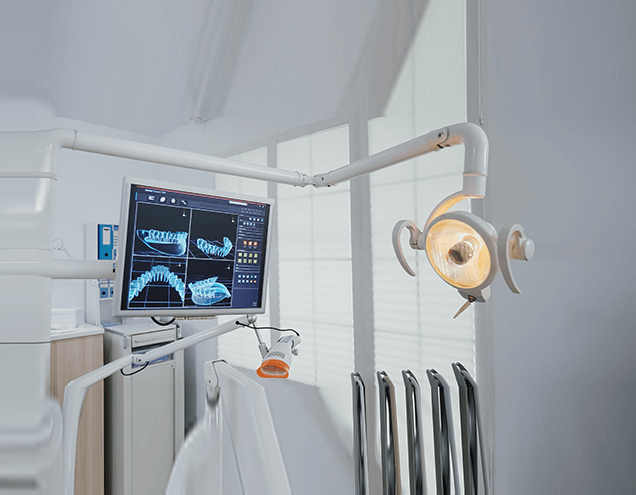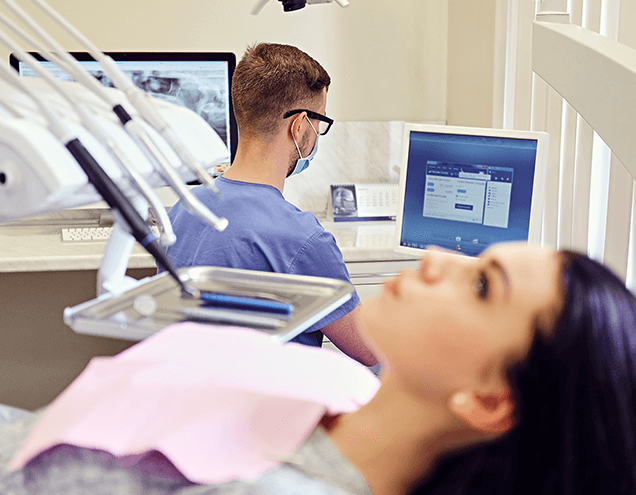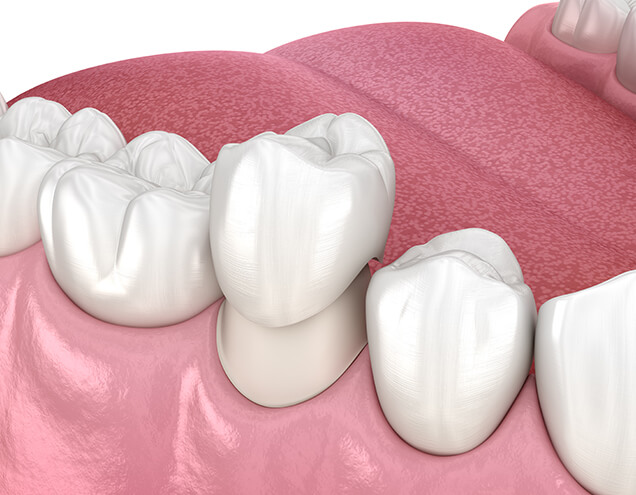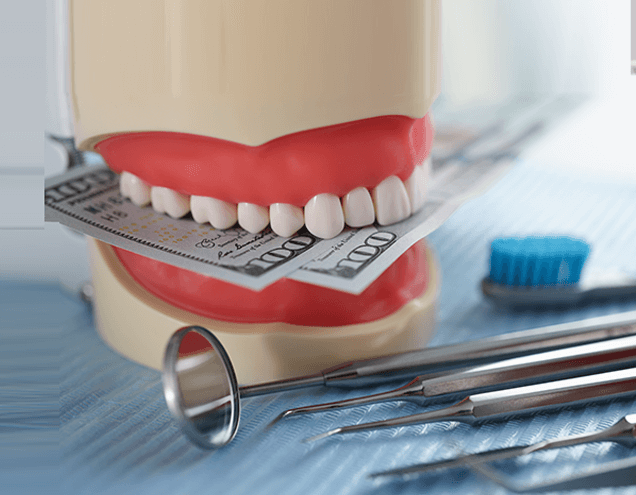

A root canal is a common dental procedure performed to clean out the pulp chamber(s) that have become diseased due to decay or trauma. (The pulp is the center of the tooth, including the nerve and blood supply.) At Smile Arizona Dentistry, we have been providing quality, effective and affordable root canal therapy in Scottsdale, AZ and surrounding communities of Tempe, Mesa, and Phoenix to help save our patients' teeth from infection and further damage.
Request an Appointment Now!
You may need a root canal if you notice any of the following symptoms:

A root canal at Smile Arizona Dentistry requires one or two visits typically. Our root canal treatment procedure includes:
Our experienced dental team will take an X-ray film of your tooth to learn the shape of your tooth's root canals and check for any signs and extent of infection in the surrounding bone. You are given local anesthesia before the procedure to numb the treatment site and keep you comfortable throughout the procedure. To isolate your tooth and keep it dry and free of saliva, our dentist will place a rubber dam around your tooth.
Our dentist will make a small hole on the biting surface of your infected tooth to remove bacteria, infection, and other debris. If it is a front tooth that is affected, the hole is made on the side, not visible to your smile. After removing infection, our dentist will identify all canal spaces of your infected tooth using dental, technical, and surgical instruments. The full length of each canal of your tooth is properly cleaned and shaped to make sure the infection and damaged areas are completely removed and treated.
The treated canal spaces are then cleaned and irrigated with a disinfecting solution. Then the canals are shaped using a series of files to ensure the infected tooth structure is completely removed, and there is adequate space for placing the canal seal (obturation) and also space for either a tooth post/filling and or crown.
The root-canaled tooth is filled and sealed (obturated with a material called gutta-percha). If the root canal procedure is not completed on the same day, our dentist will place a temporary filling to prevent the accumulation of saliva and food particles inside the tooth.
A tooth restoration and/or full-coverage crown is required after a root canal to strengthen the root-canaled tooth, protect it from further damage, and restore its full function. Our dentist will explain the importance of restoring a root canaled tooth.

Infected tooth pulp often causes very sharp or throbbing pain; this is the main way a person can self-diagnose a problem. The tooth pulp is the soft tissue that includes blood vessels and nerves. When the tooth pulp is infected or inflamed, it causes tooth pain because of the pressure that builds up from the infection in the small and unforgiving walls of a pulp chamber inside the tooth and creates the need for emergency dental assistance. We accept walk-in and same-day appointments for emergency root canal treatments, so you can get the help you need quickly.

A crown or “cap” dental restoration is required to strengthen the root-canaled tooth and prevent the remaining portion of the tooth from breaking and fracturing. A crown is required for all back teeth, including molars and pre-molars. Crowns can be used to protect a root canaled tooth, support large fillings, and restore a broken tooth. Dental crowns can be combined with bridges to provide more stability and restore the functionality of the tooth.
We offer a wide range (and all available) of crown options to help you protect your root-canaled tooth:
Typically you can plan two appointments for the dental crown procedure. During the first visit, we will examine and prepare the tooth for receiving the crown. This involves taking an X-ray, removing any residual decay, and shaping the tooth as well as making an impression of the tooth. The crown is then made in the dental lab. Our dentist will place a temporary crown while the permanent one is being made. During the second visit, we will place the permanent crown, and before cementing it, we check to ensure that it perfectly matches the rest of your teeth. Then, it will be cemented to your tooth.

Root canal cost varies depending on the factors, including the complexity of the problem, the tooth being treated (front or back teeth), the number of canal spaces, and additional treatments that may be required.
At Smile Arizona Dentistry, we work with almost all of the major insurance PPO providers to help you cover the cost of your procedure at reduced rates. We also offer an In-House Plan that gives discounts toward care. When you get your treatment plan, let us review this coverage with you.
Apart from these, we also accept all the major credit cards and work with GreenSky, CareCredit, and LendingUSA as a third party lender. With these lenders, it has never been easier to qualify. GreenSky offers a soft hit to check your qualification status. And, if you accept any one of these plans, our office pays the interest for this service for all or part of the loan.
We encourage you to apply to one or more of these sources if it will help you have care now versus delaying care only to have the infection(s) in your mouth grow and treatment become more time consuming and more costly. Again, our office pays interest for these extended payment plans, and it is easy and quick to apply and only a “soft” hit to your credit to gather this immediate information.
You usually will have immediate relief from symptoms. You may have some residual soreness for 5 to 7 days; it is rarer for this recovery time frame to be much longer. Again, during the recovery, you may experience slight discomfort or sensitivity, but it will go away within a few days. We will explain post-op root canal instructions that should be followed during recovery. However, you should call us if you experience:
It is not unusual to experience some discomfort or pain following the root canal procedure. The degree of the pain varies depending on the cause of the discomfort, circumstances of the root canal, and the foods you eat. Please also call if your comfort is not controlled or if you have any additional questions regarding your care. Taking good care of you requires that you report your symptoms to us so that we can properly advise and treat you.
Local anesthesia is used during the procedure. Anesthesia may not be required, as the tooth nerve is dead. However, to ensure patient comfort, dentists numb the treatment area.
You can eat as soon as the anesthesia wears off. However, you should avoid chewy, hard, sticky, and crunchy foods until you completely recover from the procedure. For the first 24 hours after the procedure, you should eat soft foods and drink cold beverages.
You should ideally have your appointment for your dental crown within 2 weeks after the root canal procedure. Receiving a dental restoration as soon as your root-canaled tooth feels comfortable will help prevent further infection, fracture, and damage.
A root canal is recommended to treat the infected tooth pulp, as it won’t heal on its own. If the infection is not treated on time, you can experience tooth loss or the infection can spread to other areas of your mouth and cause a dental abscess.
A dental abscess can lead to serious medical conditions such as heart attack, stroke, or even death, although thankfully, this is not common. Further, if the untreated infection cannot be brought under control, you could require inpatient or outpatient hospitalization for I.V. antibiotics to clear this spreading infection.
To avoid these complications, have your root canal treated as soon as possible after it has been diagnosed. Contact Smile Arizona Dentistry today at 480-994-5225 to learn more about all your dental conditions and needs.
Click on the button below to request your dental appointment with Smile Arizona Dentistry today!